Introduction
Few artists in history have captivated the imagination like Hieronymus Bosch. His bizarre, nightmarish visions—teeming with grotesque creatures and surreal landscapes—continue to fascinate and bewilder viewers centuries after his death. A man with a hollowed-out torso carries a tavern scene inside his body. Fish with human legs scuttle across barren landscapes. A grotesque bird-demon perches on a throne, swallowing the damned whole. This is the haunting, otherworldly universe of Bosch, where the boundaries between reality, dream, and nightmare dissolve.

As a child, I pored over art books filled with Bosch’s fantastical imagery, captivated by the sheer strangeness of his imagination. Even before I fully grasped the religious allegories and moral themes woven into his paintings, I was drawn to his world of intricate details, grotesque creatures, and dreamlike visions.
Years later, I found myself in’ s-Hertogenbosch, the city of Bosch’s birth. I stood before his bronze statue in the Markt square, just steps from where he once lived and painted. Though I have yet to see the masterpieces housed in Madrid’s Prado Museum, I have seen several Bosch paintings during my travels. I also explored the Jheronimus Bosch Art Centre, where high-quality reproductions allowed me to examine every tiny, surreal detail—free from the crowds.
Why Bosch Matters
Bosch remains one of the most enigmatic figures of the Northern Renaissance, a painter whose works blur the line between religious allegory and pure fantasy. Unlike his contemporaries, who strove for realism, Bosch crafted entire worlds—visions of heaven, hell, and human folly, populated by grotesque demons, surreal hybrid creatures, and cryptic symbols. His art continues to inspire and mystify, influencing movements from Surrealism to contemporary fantasy art.
What to Expect in This Guide
In this guide, we will explore:
- Bosch’s mind-bending imagery and theories behind his symbolism.
- The stories behind his most famous paintings.
- Where to see his surviving masterpieces today.
Step into Bosch’s strange and unsettling world and discover why his art remains as compelling today as it was 500 years ago.
Bosch’s Biography and Artistic Context
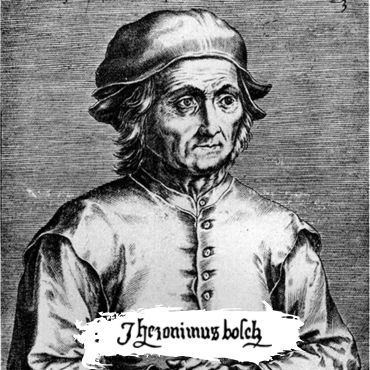
Hieronymus Bosch is one of the most mysterious painters of the Northern Renaissance. He is known for his surreal, nightmarish visions and intricate allegories. His Italian contemporaries pursued harmony, perspective, and idealized beauty. Bosch’s art, however, revelled in moral warnings, grotesque creatures, and chaotic dreamscapes. His paintings, filled with cryptic religious symbolism and social satire, continue to puzzle and fascinate viewers over 500 years after his death.
Bosch’s Early Life and Training
Born Jeroen van Aken around 1450in’ s-Hertogenbosch, Netherlands, Bosch came from a family of painters. His surname, “van Aken,” suggests a lineage tracing back to Aachen, Germany. His chosen artistic name, “Bosch,” was a tribute to his hometown, Den Bosch. Though little is known about his formal education, scholars believe that Bosch trained in his family workshop, where he developed his mastery of fine detail, vivid colour, and complex composition.
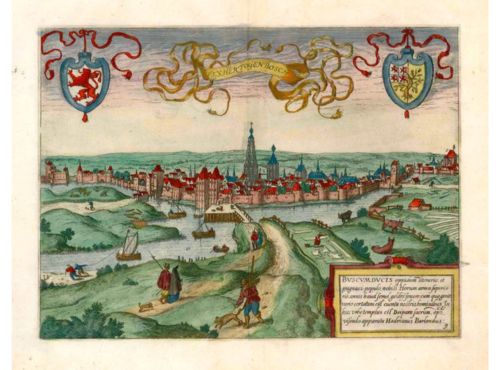
By 1480, Bosch had established himself as a prominent painter in’ s-Hertogenbosch. He married Aleyt Goyaerts van den Meervenne, a wealthy woman from a prominent local family. The marriage granted him financial security and artistic freedom. By 1488, he became a member of the Illustrious Brotherhood of Our Blessed Lady, a religious confraternity that connected him with patrons and intellectual circles. He spent most of his life in Den Bosch, where he created his most famous works, likely between 1490 and 1516. Bosch died in 1516, leaving behind paintings that would inspire artists and thinkers for generations.
A Unique Renaissance Figure
The art of the Italian Renaissance celebrated humanism, proportion, and perspective. By contrast, the Northern Renaissance—which included Early Netherlandish painting—was characterized by meticulous detail, complex iconography, and moral storytelling. Bosch belonged to this Northern tradition, but his approach was unlike anything seen before.
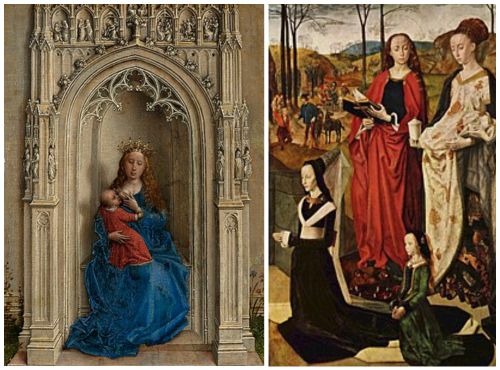
- Early Netherlandish painting (c. 1400–1500) was a school of art in the Low Countries (modern Belgium, Netherlands, and northern France), renowned for its oil painting techniques, lifelike textures, and intense realism. Artists like Jan van Eyck, Rogier van der Weyden, and Hugo van der Goes painted meticulously detailed religious scenes.
- Bosch, however, rejected traditional realism. Rather than depicting biblical stories with solemnity and grace, he filled his paintings with absurdity, horror, and grotesque humour. His works served as moral warnings, illustrating human folly, sin, and the ever-present threat of damnation.
- Bosch’s contemporaries tended to focus on courtly elegance and sacred beauty. Bosch, meanwhile, crafted otherworldly realms filled with writhing demons, surreal landscapes, and impossible creatures. His art blurs the line between religious vision and fevered nightmare.
Bosch’s Signature Themes & Style
Bosch’s distinctive artistic style sets him apart from any other painter of his time. His works feature:
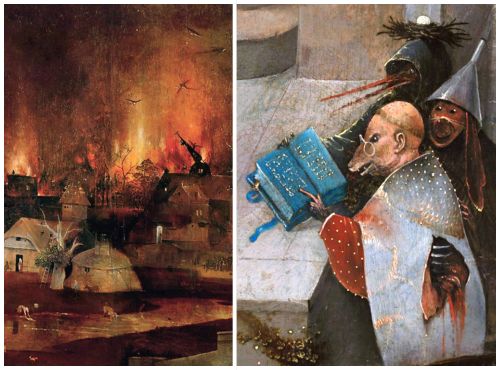
Grotesque Hybrid Creatures and Hellish Landscapes
- His paintings teem with mutant beasts, part-human hybrids, and demonic monstrosities that form crowded, surreal compositions.
- His vision of Hell—filled with twisted human forms, mechanical torture devices, and strange, bird-like demons—is among the most nightmarish depictions in Western art.
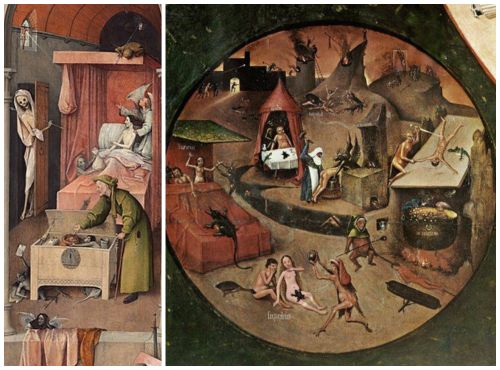
Religious and Moral Symbolism
- Bosch’s works reflect the anxieties of medieval Europe. His paintings warn against lust, greed, gluttony, and spiritual corruption.
- Many of his works are allegories of sin and redemption, though scholars continue to debate their precise meaning.
- His triptychs, such as The Garden of Earthly Delights and The Haywain, reveal stages of moral downfall. These moralistic works urge viewers to contemplate their own fate.
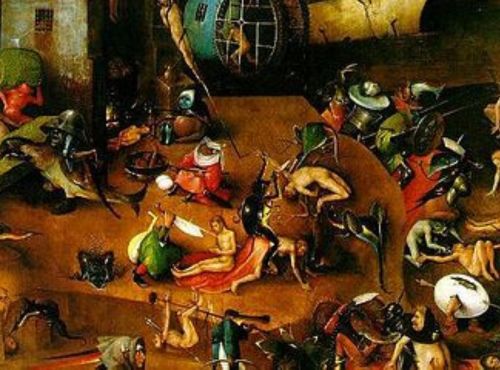
Brilliant, Jewel-Like Colours and Fine Detail
- Despite his dark themes, Bosch’s paintings are visually stunning. He often uses bright blues, deep reds, and glowing yellows.
- His obsessive attention to detail allows for dozens of tiny, hidden narratives within each painting, making his works endlessly fascinating.
Bosch remains an artist ahead of his time, creating worlds that continue to unsettle, inspire, and provoke deep reflection. His hallucinatory visions and intricate allegories cement his place as one of history’s most fascinating and mysterious painters.
Bosch’s Masterpieces and Artistic Contributions
Hieronymus Bosch’s strikingly imaginative and often unsettling paintings remain some of the most curious and discussed works in Western art. His bizarre, otherworldly visions set him apart from his Early Netherlandish and Italian Renaissance contemporaries. While artists such as Jan van Eyck and Rogier van der Weyden focused on naturalistic detail, religious solemnity, and humanistic precision, Bosch took a different approach. He populated his works with grotesque creatures, moral allegories, and chaotic dreamscapes. Bosch thus created a unique visual language that continues to fascinate scholars and viewers alike.
The Bosch Triptych: A Gateway to Strange Worlds
Many of Bosch’s most celebrated works are triptychs—three-paneled altarpieces that were commonly used in religious settings during the Northern Renaissance. Traditionally, these triptychs featured central biblical scenes flanked by panels depicting saints or donors. Such works were intended to instill awe and inspire devotion. Bosch, however, transformed the triptych into a narrative experience. His paintings take the viewer on a mystical, nightmarish, or satirical journey through heaven, earth, and hell.
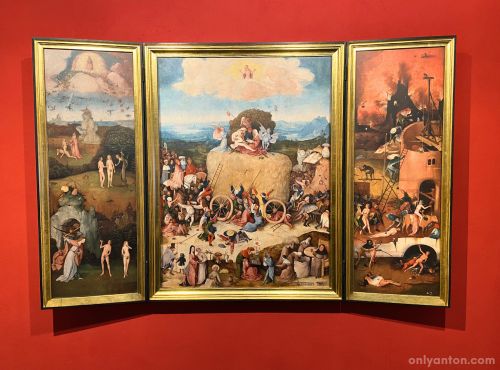
Unlike the serene compositions of Italian Renaissance altarpieces, Bosch’s works rejected idealized beauty and balanced perspective. Instead, he favoured crowded, chaotic storytelling while embracing a dense, miniature-like precision. Tiny vignettes unfold in surreal and often grotesque detail. Each of his triptychs acts as a moral lesson, an unsettling warning, or an allegorical puzzle that continues to inspire debate.
Below are four of Bosch’s most famous and significant masterpieces. Each offers a glimpse into his strange and captivating imagination.
A. The Garden of Earthly Delights (c. 1490–1510)
📍 Where to See It: Prado Museum, Madrid
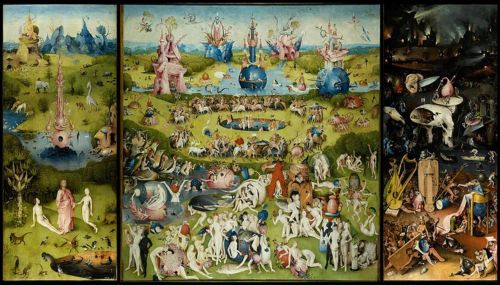
Perhaps Bosch’s most famous and debated work is The Garden of Earthly Delights. This masterpiece is a monument to the fantastical, the moralistic, and the utterly bizarre. Experts often interpret the triptych as a warning against sin, a vision of paradise lost, or even a satire on human folly.
What’s in the Painting?
The triptych unfolds in three parts:

The Left Panel (Paradise / Eden): A lush garden where God introduces Eve to Adam. But even here, Bosch’s fantastical elements are at play—strange animals lurk, and the seeds of temptation are already present.
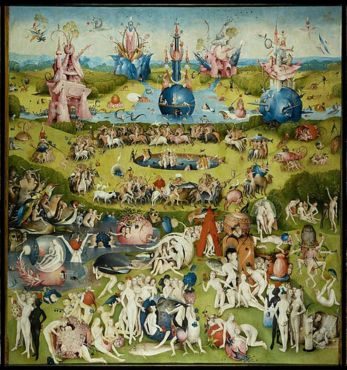
The Center Panel (Earthly Pleasures): A densely populated landscape filled with naked humans, oversized fruits, and surreal hybrid creatures, where men and women indulge in hedonistic pleasures.
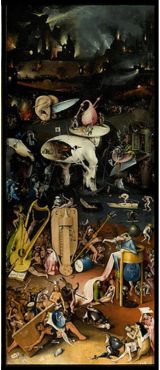
The Right Panel (Hell): A dark, nightmarish vision where Bosch’s imagination runs wild. Musical instruments become torture devices, grotesque demons torment the damned, and eerie fires consume the background.
Interpretation and Legacy
- Some scholars view the painting as a moral warning, illustrating the inevitability of sin leading to damnation.
- Others interpret it as a utopian world where humanity lives without shame or consequence.
- Regardless of meaning, The Garden of Earthly Delights remains one of art’s most astonishingly detailed and ambitious paintings, inspiring Surrealists like Salvador Dalí and Max Ernst centuries later.
B. The Haywain Triptych (c. 1512–1516)
📍 Where to See It: Prado Museum, Madrid
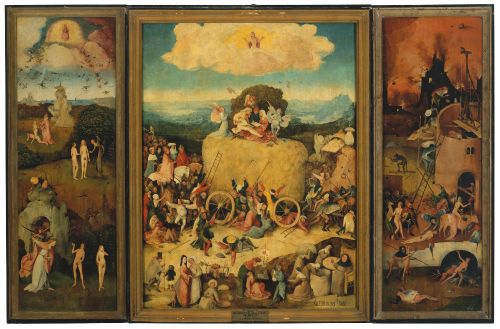
The Haywain Triptych is another allegorical masterpiece, this time focused on human greed and the fleeting nature of material wealth.
What’s in the Painting?
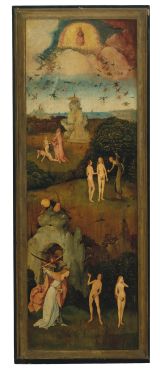
The Left Panel (Paradise & the Fall of Man): Adam and Eve are expelled from Eden, setting the stage for humanity’s downfall.
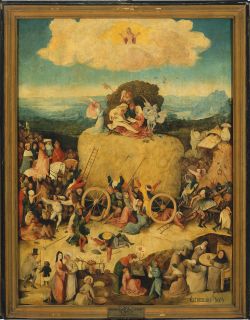
The Center Panel (The Haywain Procession): A mass of people, clergy, and nobles chase after a giant hay cart, symbolizing worldly wealth and vanity. The hay is useless, yet people fight and trample each other to get a share.
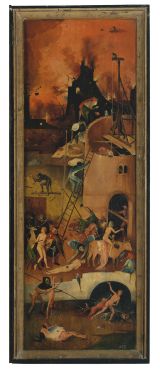
The Right Panel (Hell): Those who chased material pleasures in life now suffer eternal torment in the afterlife, much like in The Garden of Earthly Delights.
Why It’s Important
- The Haywain Triptych reinforces Bosch’s pessimistic view of human nature, showing how society’s obsession with wealth leads to ruin.
- The work influenced later artists and writers who sought to criticize social corruption and vanity.
C. The Last Judgment (c. 1482–1516)
📍 Where to See It: Academy of Fine Arts, Vienna
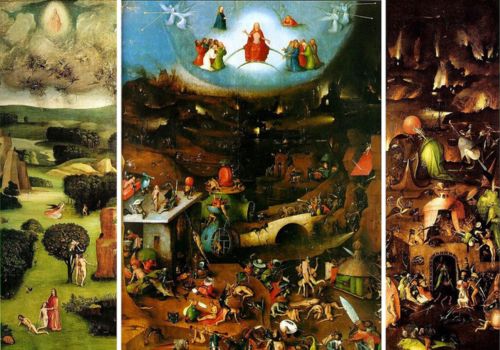
The Last Judgment is a terrifying, apocalyptic vision of the end of time. The painting is filled with grotesque demons, sinners undergoing eternal punishment, and Bosch’s signature surreal horror.
What’s in the Painting?
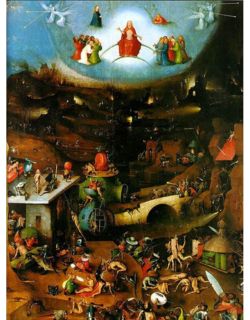
- The top section features Christ and the angels, judging the souls of the living and the dead.
- The central section shows humanity being divided, some ascending to heaven, others falling into damnation.
- The bottom section (Hell) is one of Bosch’s most disturbing creations—tortured figures, monstrous demons, and eerie landscapes form a macabre nightmare.
Why It’s Important
- This work exemplifies Bosch’s obsession with divine justice and reflects the fear-driven religious climate of medieval Europe.
- The painting’s hellish imagery has influenced centuries of horror art, literature, and modern fantasy.
D. The Temptation of St. Anthony (c. 1501)
📍 Where to See It: National Museum of Ancient Art, Lisbon
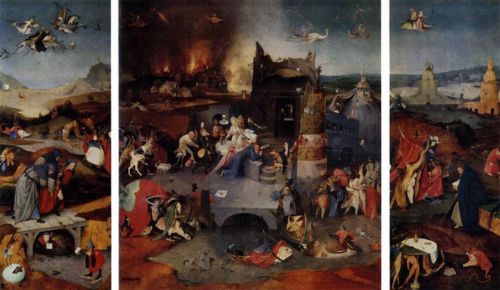
This smaller but incredibly detailed work demonstrates Bosch’s preoccupation with spiritual warfare, temptation, and the supernatural.
What’s in the Painting?
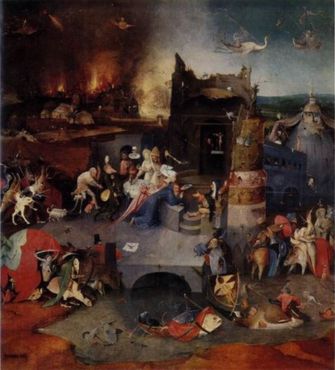
- The central figure, St. Anthony, remains calm and steadfast despite being surrounded by grotesque demons and hallucinatory visions.
- The landscape is chaotic and surreal, with floating structures, monstrous birds, and dark storm clouds.
- The painting is packed with bizarre details, including creatures performing strange rituals and demons disguised as humans.
Why It’s Important
- The Temptation of St. Anthony represents a deeply psychological take on faith that shows the inner struggles of devotion amid overwhelming temptation.
- The work is considered a precursor to modern surrealist dreamscapes.
Final Thoughts on Bosch’s Masterpieces
Bosch’s triptychs and panel paintings transport viewers into dreamlike landscapes filled with moral lessons, grotesque creatures, and hidden narratives. His works challenge us to decipher their meanings even five centuries later.
Where to See Bosch’s Work Today
Hieronymus Bosch’s mystifying, surreal masterpieces are scattered across some of the world’s most prestigious museums. Most of his works remain in Spain, the Netherlands, Austria, France, and Portugal. Still, there are a few lesser-known collections where one can find Bosch’s drawings and workshop paintings. Whether you want to see The Garden of Earthly Delights up close or examine his grotesque, nightmarish visions in a quieter setting, this guide will help you plan your visit to the best Bosch destinations.
Major Museums Featuring Bosch’s Works
Prado Museum (Madrid, Spain) – The Ultimate Bosch Collection
📍 Home of The Garden of Earthly Delights
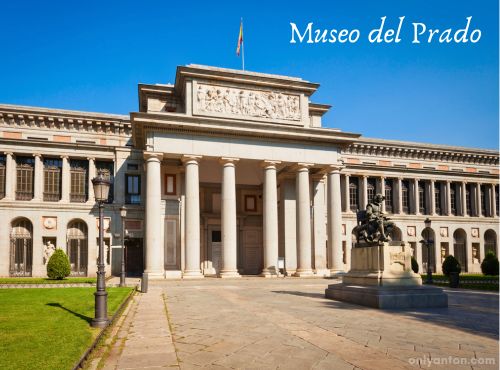
The Museo del Prado in Madrid is the definitive destination for Bosch enthusiasts, holding the largest and most important collection of his original works. The museum’s Bosch Room features:
- The Garden of Earthly Delights (c. 1490–1510) – Bosch’s most famous masterpiece, an enigmatic triptych filled with surreal creatures, moral allegory, and extraordinary detail.
- The Haywain Triptych (c. 1512–1516) – A procession of people following worldly pleasures, only to meet their doom in hell.
- The Adoration of the Magi (c. 1495–1500) – A striking nativity scene infused with Bosch’s signature grotesque figures and hidden symbolism.
⭐ Must-See Factor: ⭐⭐⭐⭐⭐ (The ultimate Bosch pilgrimage site)
Museum Boijmans Van Beuningen (Rotterdam, Netherlands) – A Dutch Treasure Trove
📍 Home of Bosch’s drawings and workshop paintings
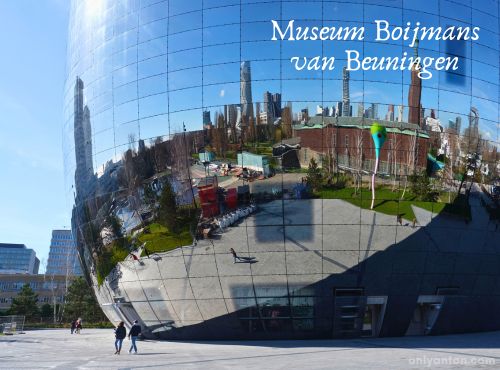
While Rotterdam’s Museum Boijmans Van Beuningen does not house Bosch’s most famous paintings, it contains a significant collection of his drawings and works from his workshop. The museum also holds:
- The Pedlar – A small but significant Bosch painting depicting a wandering figure caught between virtue and vice.
- Detailed studies and sketches that offer insight into Bosch’s intricate creative process.
⭐ Must-See Factor: ⭐⭐⭐⭐ (Essential for those interested in Bosch’s technique and preparatory works)
Academy of Fine Arts (Vienna, Austria) – Bosch’s Apocalyptic Vision
📍 Home of The Last Judgment
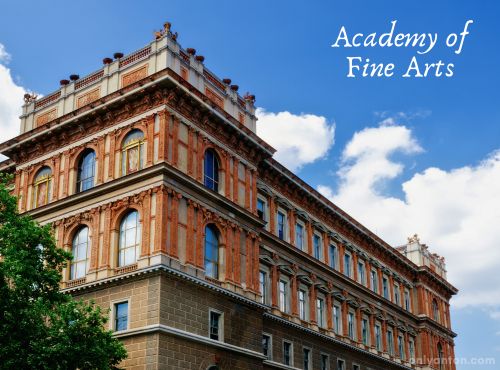
Vienna’s Academy of Fine Arts is home to one of Bosch’s most terrifying and grand apocalyptic visions.
- The Last Judgment (c. 1482–1516) – A hellscape teeming with nightmarish demons, sinners undergoing eternal punishment, and one of Bosch’s most intricate depictions of divine retribution.
⭐ Must-See Factor: ⭐⭐⭐⭐ (A haunting, unforgettable Bosch masterpiece)
National Museum of Ancient Art (Lisbon, Portugal) – Bosch’s Supernatural World
📍 Home of The Temptation of St. Anthony
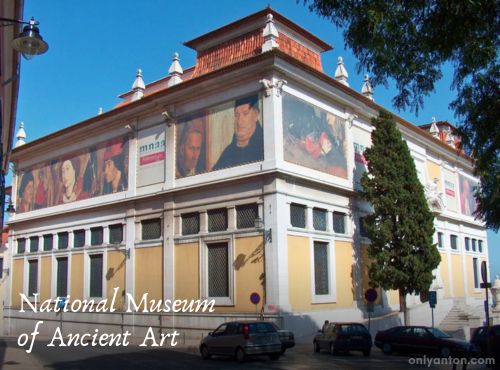
Lisbon’s National Museum of Ancient Art offers one of Bosch’s most richly detailed, eerie, and mystical paintings:
- The Temptation of St. Anthony (c. 1501) – A hallucinatory vision filled with flying fish, grotesque demons, and spiritual warfare.
⭐ Must-See Factor: ⭐⭐⭐⭐ (A rewarding stop for those drawn to Bosch’s supernatural themes)
Jheronimus Bosch Art Centre (’s-Hertogenbosch, Netherlands) – A Complete Experience
📍 Reproductions of Bosch’s entire body of work
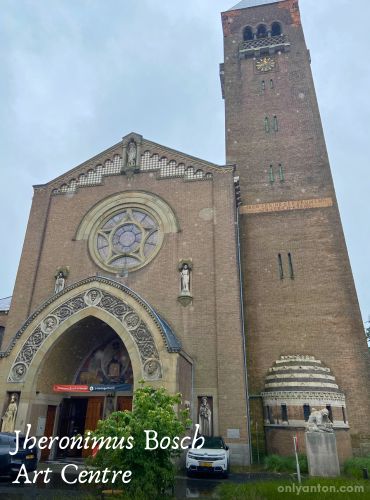
While it does not contain original Bosch paintings, the Jheronimus Bosch Art Centre is still a must-visit site for Bosch enthusiasts.
- High-quality reproductions of all Bosch’s works allow visitors to examine every tiny detail without the crowds.
- Sculptural recreations of Bosch’s creatures bring his bizarre visions to life.
- Interactive exhibits and digital reconstructions help visitors explore Bosch’s world in depth.
⭐ Must-See Factor: ⭐⭐⭐⭐ (Perfect for those who want to see Bosch’s works in an intimate, interactive setting)
Travel Tips for Bosch Enthusiasts
Best Times to Visit the Prado
- Avoid peak crowds by visiting early in the morning (right at opening) or late afternoon.
- Weekdays are less crowded than weekends, especially Tuesdays and Wednesdays.
- Book a skip-the-line ticket or join a guided tour for a more focused experience.
Visit Lisbon or Vienna for a Quieter Experience
- The National Museum of Ancient Art (Lisbon) and the Academy of Fine Arts (Vienna) both house major Bosch works but are far less crowded than the Prado.
- These museums offer a more personal, immersive experience, allowing visitors to study Bosch’s details without distraction.
Hidden Gems: Lesser-Known Bosch Works
Some major museums and smaller collections hold lesser-known works or workshop pieces and drawings, including:
- The Louvre (France) – Home of Ship of Fools (c. 1490–1500), a satirical allegory of human folly featuring drunken, aimless figures aboard a rudderless ship.
- National Gallery of Art (Washington, D.C.) – Home of Death and the Miser (c. 1490), a grim meditation on wealth, morality, and the inevitability of death.
- The Escorial Monastery (Spain) – Holds additional Bosch panel paintings, though they are lesser known.
- Berlin’s Gemäldegalerie (Germany) – Features Bosch-inspired paintings, revealing his artistic influence.
Tips for Art Lovers
- Don’t just take photos—study the details. Bosch filled his paintings with tiny, hidden narratives that reward patient observation.
- Read about interpretations in advance. Many Bosch paintings remain highly debated, so learning about their possible meanings before seeing them in person enriches the experience.
- Consider visiting the Jheronimus Bosch Art Centre first. Since it contains reproductions of all his works, visitors can familiarize themselves with his paintings before seeing the originals.
Bosch’s Legacy & Influence
Hieronymus Bosch’s work continues to inspire, mystify, and unsettle audiences more than 500 years after his death. His surreal landscapes, grotesque creatures, and densely packed moral allegories set him apart from other artists of the Northern Renaissance, and his influence extends far beyond his own era. From Netherlandish painters like Pieter Bruegel to Surrealist visionaries and modern pop culture, Bosch’s legacy is as alive today as it was in the 16th century.
Artistic Influence of Hieronymus Bosch
Bosch’s highly imaginative, nightmarish style left a profound impact on the Netherlandish painting tradition, most notably influencing Pieter Bruegel the Elder and subsequent Dutch painters.
- Bruegel borrowed Bosch’s satirical and allegorical elements, particularly in works like The Triumph of Death and Dulle Griet (Mad Meg).
- Unlike Bosch, Bruegel focused more on human folly through peasant scenes, but his chaotic compositions and dark, apocalyptic themes clearly show Bosch’s influence.
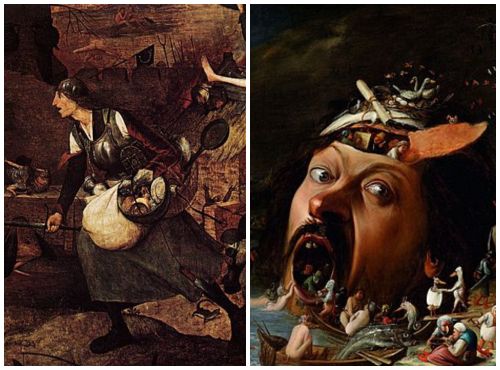
Bosch’s reputation grew even stronger in later centuries, influencing:
- Mannerist and Baroque painters who emulated his dense, detailed compositions.
- 19th-century Romantics who were fascinated by his visionary dreamscapes.
- 20th-century Surrealists who embraced his bizarre creatures and subconscious imagery.
Notable artists who drew inspiration from Bosch include:
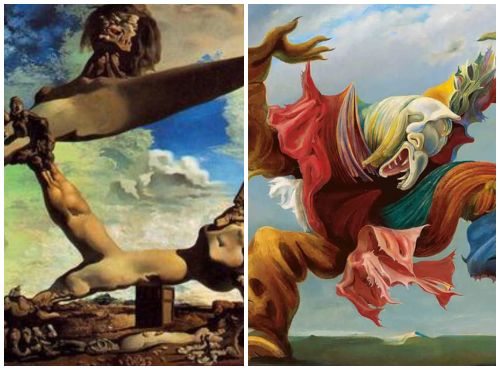
- Salvador Dalí – His melting landscapes and dreamlike absurdities owe much to Bosch’s fantastical settings.
- Max Ernst – His collage-style creatures and dystopian worlds were heavily influenced by Bosch’s grotesque hybrids.
- Francis Bacon – The horrifying contortions of human flesh in his paintings echo Bosch’s tormented souls and monstrous figures.
- H. R. Giger (Alien franchise) – The biomechanical nightmarish aesthetic of the Xenomorph has parallels with Bosch’s twisted, humanoid demons.
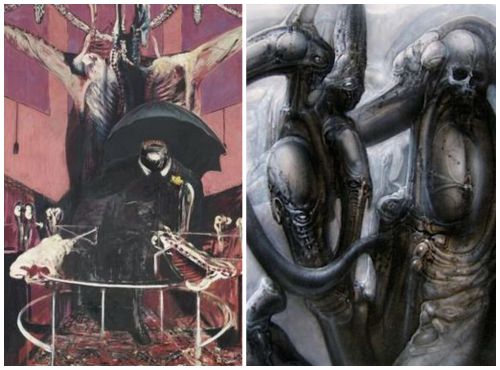
Bosch’s macabre, visionary art has ensured that his style remains a cornerstone of dark, fantastical imagery.
Bosch in Pop Culture
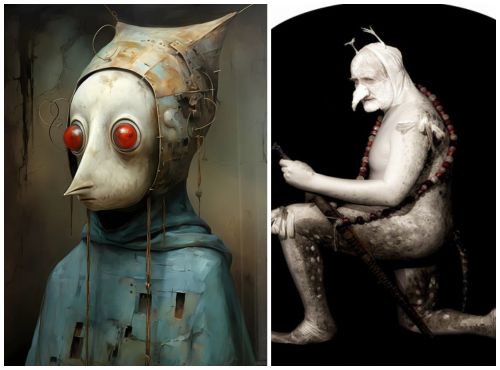
Bosch’s grotesque, surreal imagery has transcended the art world, appearing in fashion, film, and video games. His nightmarish creatures and symbolic storytelling have shaped the aesthetics of fantasy and horror genres in particular.
Fashion & Design
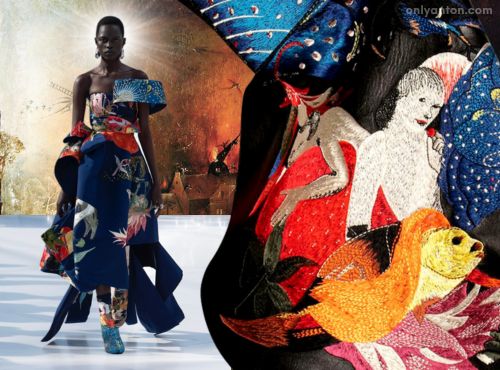
- Several high-profile fashion designers have incorporated Boschian imagery into their collections.
- His demons, hybrid monsters, and fiery infernos have appeared in runway prints, haute couture, and streetwear brands.
- Designers like Alexander McQueen and Viktor & Rolf have drawn from Bosch’s dark fantasy elements, reinterpreting his chaotic beauty in textiles and patterns.
Films & Video Games
Bosch’s apocalyptic and surreal worlds have inspired many filmmakers and game designers.
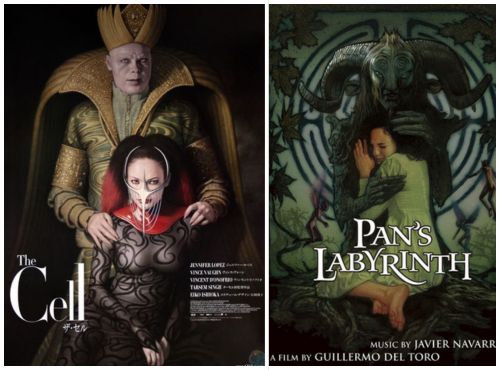
- Guillermo del Toro’s Pan’s Labyrinth (2006) – The film’s grotesque, otherworldly creatures, such as the Pale Man, are reminiscent of Bosch’s hybrid monsters.
- The Cell (2000) – The film’s dream sequences, featuring nightmare landscapes and contorted human forms, were directly inspired by Bosch’s hellish visions.
- Dark Souls (Video Game Series, 2011–present): This gothic fantasy series features twisted, Bosch-like creatures and apocalyptic landscapes reminiscent of The Garden of Earthly Delights.
- Other video games, including Bloodborne, Dante’s Inferno, and Silent Hill, borrow Bosch’s aesthetic of sin, punishment, and surreal horror.

The imaginative grotesqueries of Hieronymus Bosch have cemented his place in the modern imagination, influencing fantasy and horror storytelling across multiple mediums.
Bosch’s Enduring Mystery
Despite centuries of study, Bosch remains an enigma. Unlike Leonardo da Vinci or Albrecht Dürer, Bosch left behind no notebooks, treatises, or written explanations of his work. His symbolism, religious beliefs, and esoteric influences remain open to speculation.
- Some scholars believe Bosch’s art reflects medieval Catholic teachings, reinforcing the doctrine of sin, temptation, and damnation.
- Others argue that his works satirize religious hypocrisy, offering a more cynical view of human folly.
- Some theorists suggest Bosch was influenced by alchemy, secret societies, or heretical movements, though no definitive evidence exists.
This lack of written documentation has only deepened the fascination with Bosch’s art. His works continue to challenge viewers, inviting endless interpretations and speculation.
Final Thoughts on Bosch’s Influence
From Renaissance allegory to Surrealist masterpieces, from horror films to avant-garde fashion, Bosch’s nightmarish visions continue to captivate and unsettle audiences across the centuries. His ability to blend morality, absurdity, and pure imagination ensures that his legacy remains eternally relevant and ever-mysterious.
Reflection on Hieronymus Bosch
My Personal Takeaway
Standing in the Jheronimus Bosch Art Centre in’ s-Hertogenbosch, surrounded by life-sized reproductions of Bosch’s eerie, surreal worlds, I was struck by the difference in experiencing his work in a quieter, more intimate setting. Unlike major museums where crowds jostle for a glimpse of a masterpiece, this visit allowed me to stand in front of each piece for as long as I wanted, absorbing every strange hybrid creature, every unsettling vignette, every intricate, near-microscopic detail.
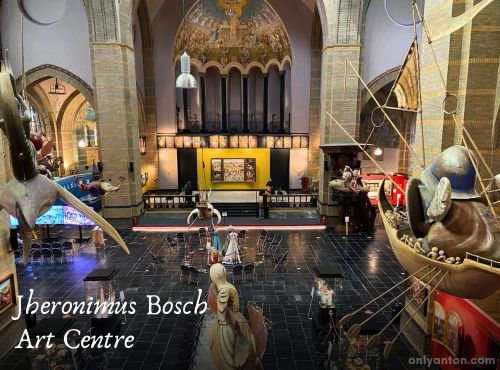
Though these were not the originals, the experience was profoundly rewarding. It was a reminder that art appreciation is not only about seeing famous works in person. It is also about taking the time and space to engage with artworks fully. Bosch’s paintings demand this kind of deep contemplation, rewarding those who linger with hidden narratives and surreal discoveries.
While I have yet to stand before The Garden of Earthly Delights at the Prado, my time in’ s-Hertogenbosch reaffirmed why Bosch remains one of my favourite artists. His work is not just to be looked at but explored, puzzled over, and marvelled at with a childlike curiosity.
Conclusion
Hieronymus Bosch’s visionary imagination still resonates today, offering an unparalleled glimpse into the fears, desires, and dreams of humanity. His nightmarish creatures, enigmatic allegories, and exceptional creativity make him one of the most intriguing figures in Western art history. Whether interpreted as moral warnings, surreal fantasies, or reflections of medieval anxiety, Bosch’s paintings remain endlessly fascinating, challenging us to find meaning in their layered, dreamlike worlds. For those drawn to mystery, surrealism, and the macabre, Bosch’s work is an essential experience, one that lingers long after the canvas fades from view.
What About You?
- What is your favourite Bosch painting, and why?
- Have you ever seen Bosch’s works in person? If so, what was your experience like?
- Do you think Bosch’s visions were pure imagination, or do they reflect the real fears and beliefs of his time?
Drop your thoughts in the comments. I’d love to hear your interpretations of Bosch’s bizarre and fascinating world!
Further Reading & Resources
For those who want to dive deeper into the world of Hieronymus Bosch, here are some carefully curated resources, including related blog posts, insightful books, documentaries, and reputable websites.
Related Posts on Only Anton
- How to Get the Most Out of Your Museum Visit: Learn how to appreciate art like a pro with tips on planning your visit, engaging with art, and making the most of your museum experience.
- The Best of Den Bosch: A Guide to ‘s-Hertogenbosch: Discover the medieval charm of Den Bosch, Bosch’s hometown, where you can explore his legacy, historical sites, and the famous Bossche Bollen pastry.
- Aachen Travel Guide: Explore Aachen, a historic European gem, and uncover its cultural wonders, unique architecture, and artistic connections to Bosch’s era.
- An Art Lover’s Guide to Gustav Klimt: Explore Gustav Klimt’s art, life, and legacy. Discover his masterpieces and why his golden style continues to captivate art lovers today.
External Resources
Books on Hieronymus Bosch
- Bosch: The Complete Works by Stefan Fischer (2021) – A comprehensive, large-format book featuring high-resolution reproductions of all Bosch’s paintings, complete with expert analysis. Find it at your library, browse online, or grab your copy here.
- Hieronymus Bosch: Visions and Nightmares by Nils Büttner (2016) – A compact, well-researched book that explores Bosch’s life, religious themes, and surreal imagery. Check your local library, search online, or order a copy here.
- Jheronimus Bosch: The Road to Heaven and Hell by Gary Schwartz (2016) – A highly readable, accessible guide to Bosch’s allegories and moral themes. Discover it at your library, look it up online, or purchase your copy here.
- Hieronymus Bosch: Between Heaven and Hell by Walter Bosing (2015) – A richly illustrated book that explores Bosch’s symbolism, religious themes, and moral allegories, placing his work within the context of medieval thought and Renaissance culture. See if your library has it, look online, or snag a copy here.
- Hieronymus Bosch: Visions of Genius by Matthijs Ilsink and Jos Koldeweij (2016) – Published alongside the landmark 2016 Bosch exhibition, this book presents the latest research, high-quality reproductions, and insights into Bosch’s enigmatic masterpieces, shedding new light on his artistic techniques and hidden meanings. Look it up at a local library, browse online, or buy your copy here.
Documentary
- The Curious World of Hieronymus Bosch (2016) – A documentary directed by David Bickerstaff that explores the intricate details and hidden symbolism within Bosch’s paintings.
Reputable Websites & Articles
- The Prado Museum’s Bosch Collection – Explore high-resolution images of Bosch’s works housed at the Prado.
- Jheronimus Bosch Art Centre – The official site of the Jheronimus Bosch Art Centre in’ s-Hertogenbosch, featuring exhibits, research, and events.
- Museum Boijmans Van Beuningen – Rotterdam’s premier art museum with a notable collection of Bosch-related works, including drawings and paintings by his followers, showcasing his influence on later Netherlandish art.
- Academy of Fine Arts, Vienna – Home to Bosch’s The Last Judgment, this renowned academy offers historical context for the painting while housing a prestigious art collection featuring Old Masters.
- National Museum of Ancient Art, Lisbon – A must-visit for Bosch enthusiasts, housing The Temptation of St. Anthony, one of his most detailed and enigmatic triptychs, alongside a rich collection of European Renaissance art.
- National Gallery of Art, Washington, D.C. – Features Bosch’s Death and the Miser, Bosch-related works, and his influence on later painters. The site offers high-resolution images, research articles, and interactive exhibits on European Old Masters.
- Louvre Museum, Paris – Holds Bosch’s Ship of Fools, one of his most famous moral allegories, alongside a vast collection of early Netherlandish and Renaissance art.
- The Escorial Monastery, San Lorenzo de El Escorial, Spain – Home to The Adoration of the Magi by Bosch, this royal monastery and palace features a collection of religious artworks acquired by King Philip II, one of Bosch’s greatest admirers.
- Gemäldegalerie, Berlin – One of the world’s most important collections of European paintings, featuring works by Bosch’s followers, offering insight into his lasting influence on later Netherlandish art.
- The Bosch Research and Conservation Project – A detailed site that documents the latest findings, conservation efforts, and technical analysis of Bosch’s works.
- Google Arts & Culture: Hieronymus Bosch – A virtual experience of Bosch’s paintings, allowing you to zoom in and explore intricate details.
Works Cited (in order of appearance)
Images used in this post are for educational and commentary purposes under Fair Use principles. Sources are credited, and permissions are obtained for licensed materials where possible.
- Rogier van der Weyden, Virgin and Child Enthroned, 1430-1432. Oil on panel. Museo Thyssen-Bornemisza, Madrid.
- Hugo van der Goes, Portinari Altarpiece, 1475-1476. Oil on wood. Uffizi Gallery, Florence.
- Hieronymus Bosch, Death and the Miser, 1490-1516. Oil on panel. National Gallery of Art, Washington D.C.
- Hieronymus Bosch, The Seven Deadly Sins and the Four Last Things, c. 1500. Oil on panel. Museo del Prado, Madrid.
- Hieronymus Bosch, The Last Judgment, 1482. Oil on panel. Academy of Fine Arts, Vienna.
- Hieronymus Bosch, The Garden of Earthly Delights, 1490–1510. Oil on panel. Museo del Prado, Madrid.
- Hieronymus Bosch, The Haywain Triptych, 1516. Oil on panel. Museo del Prado, Madrid.
- Hieronymus Bosch, Triptych of the Temptation of St. Anthony, 1501. Oil on panel. Museo Nacional de Arte Antiga, Lisbon.
- Pieter Bruegel the Elder, Dulle Griet (Dull Gret or Mad Meg), 1563. Oil on panel. Museum Mayer van den Bergh, Antwerp.
- Joos van Craesbeeck, The Temptation of St. Anthony, c. 1650. Oil on Canvas. Staatliche Kunsthalle Karlsruhe, Karlsruhe, Germany.
- Salvador Dalí, Soft Construction with Boiled Beans (Premonition of Civil War), 1936. Oil on canvas. Philadelphia Museum of Art, Philadelphia.
- Max Ernst, The Angel of Hearth and Home (L’Ange du Foyer), 1937. Oil on canvas. Private collection.
- Francis Bacon, Painting 1946, 1946. Oil on linen. Museum of Modern Art, New York.




